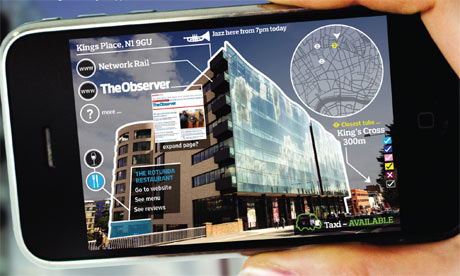What is Augmented Reality?
So, what is augmented reality?
By definition Augmented Reality is is a live, direct or indirect, view of a physical, real-world environment whose elements are augmented by a computer-generated sensory input such as sound, video, graphics or GPS data.
In this example we can see that data about the environment is layered onto the phone screen. I am going to show you a few examples of apps that have been developed using augmented reality technology.
Google Sky Map
An augmented reality app which makes learning about astronomy interesting and fun. Instead of looking at descriptions of constellations in a book and then attempting to identify them in the sky, you can use Google Sky Map to directly identify stars and constellations using the camera on your smartphone. This a great tool for students or anyone interested in outer space.
Fetch! Lunch Rush
Developed by PBS Kids to teach math skills to elementary students through the use of visualization. uses your smartphone camera to place graphics on your camera over real-world surroundings. The app then teaches elementary students to add and subtract using real-world scenarios which allow for visualization while solving math problems. I think this could be a great tool for future generations and will eventually replace traditional learning techniques such as physical textbooks.
Zooburst
A digital storybook that can be customized using a library of thousands of images and users can add Adobe flash animations, narrations, and speech balloons to the story. Once the book is completed, students can become a part of the story via webcam. Again, this is a great learning tool and could spark creativity among our youth.
So what’s the next big thing in augmented reality? Google has been developing Google Glass and it will be the first commercially sold head mounted augmented reality system. Its lighter then the average pair of sunglasses and has many useful features such as 720p HD video which is crystal clear quality, it can take photos which can be shared and uploaded instantly, It has GPS functionality, which uses Google maps for the necessary data And of course it will replace the need for a phone as it has calling capabilities and it’s a hands free device.
Google has spent a lot of resources developing the physical headset. The end result is a device that is lightweight, flexible and strong. At some point, everyone is going to want one of these and I foresee them being very popular.
The only problem that is apparent now is that there could be potential privacy issues. You may be able to identify strangers in the public and record and broadcast conversations which is dangerous and will anger a lot of people. there are also some legality issues with it in countries such Russia and the Ukraine.
